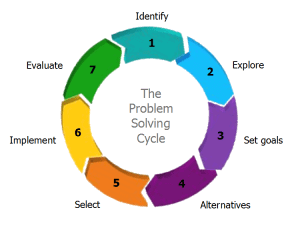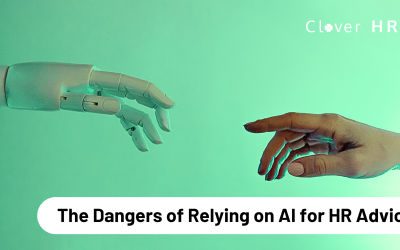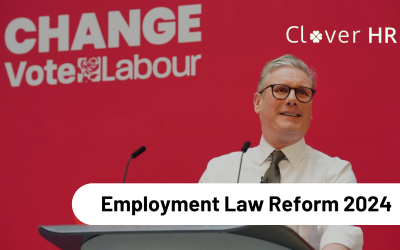Problem-solving is the process followed in order to identify a problem and its source, and then find a solution to it. The ability to problem-solve is really important to an employer as problems crop up in any workplace. They will want all employees to have the ability to identify issues and be part of putting the solution in place. It helps to promote independence and ownership in the workplace, and it highlights your ability to carry out a range of other skills.
Although problem-solving is often listed as a skill on its own, there is a range of skills that contribute to being an effective problem solver. These include:
- Active listening
- Analysis
- Research
- Creativity and creative thinking
- Communication
- Time-management
- Decision making
- Teamwork
- Project management
The problem-solving cycle
Identifying and solving a problem has seven steps. These are shown in the diagram below. Each step requires you to draw on a different skill within your problem-solving bank.
Identify
How a problem is identified will vary – it may appear by chance, or you may have found it as part of another task you are carrying out, such as taking a phone call or running a report. It may be that something happens that highlights there is a problem, but you’re unsure as to what the problem is. This is where you will need to draw on your own knowledge, the knowledge of others, as well as your research and analysis skills to find the problem.
Explore
Once the problem has been identified, you will need to locate its source. To do this you will need to fully research the problem and identify how this will be approached.
You may need to talk to others – which is where your listening and communication skills come into play. You may need to carry out your own research into the problem and analyse any data.
It’s possible at this stage that you may need to work as a team to explore the problem, depending on how big it is and the expertise required to try to solve it.
Set goals
Set clear goals and timescales for yourself and others involved in exploring the problem. This is important for the problem to be solved in a timely manner. You will need to draw on your time management and project management skills here to ensure everyone is on track, and knows what they are doing.
Alternatives
Once the problem has been fully explored, you and the team will need to access your creative thinking skills to consider all the possible options to solving the problem. A good way to record and critique your ideas is by creating a mind map. Drawing on your listening skills here will be key to making sure everyone can get involved and nothing is missed.
Select the solution
Now you have all the ideas on the table, it’s time to draw on your decision-making skills and decide the best way forward. It would also be useful to identify how you will know the solution has been successful so that you can evaluate against this.
Implement
Implementing your solution will mean accessing your project management and team working skills again. Good communication is also key here in ensuring everyone knows the part they will play, and what the timescales are. Create an action plan which details this so that everyone can view it, is able to support each other, and can hold each other accountable.
Evaluate
This is the last step in the problem-solving cycle…but it is an important one. Evaluate the solution against your pre-defined success criteria to help you decide whether or not an effective solution to the problem has been reached.
If you have reached your goal then that’s job done…or if not, it may be that you need to revisit earlier parts of the cycle to explore further, or consider an alternative solution.
Common questions
Before attending an interview, it’s useful to prepare for potential questions and think of examples you can use as part of your answer. Examples are good because they show how you have already demonstrated the skill.
Some common problem-solving interview questions include:
- Describe a time when you faced an unexpected challenge at work.
- How would you handle a dissatisfied customer?
- Describe a situation where you had to solve a problem at work and the role you played.
- Give an example of a situation in which you saw an opportunity in a potential problem. What did you do?
- What steps do you take before deciding on how to solve a problem, and why?
- Tell me about a time when you became aware of a potential problem and resolved it before it became an issue.
Structuring your answer
A useful way to structure your answers is to use the STAR method. Firstly, think about an example to share as part of your answer, then use the steps below to help you respond clearly and fully.
S – Situation
In this section, talk about the situation itself. Describe the context in which you were working or the challenge you were facing.
T – Task
This section talk about the tasks which needed to be completed in order to resolve or address the situation. What were you asked to do, or what did you decide to do?
A – Action
In this section talk about what your responsibility was in completing the tasks. Focus on the part you played specifically and how you contributed, rather than what your team or colleagues did.
R – Result
In this section, talk about what the outcome was, and what you achieved.
Some people also add an additional “R” at the end for Reflection. Here, you could talk about what you felt went well, and if there would be anything you would change next time.
For more information on the STAR method, please see our blog.
STAR Method – How to Answer Interview Questions the Right Way – Clover HR
Highlighting problem-solving skills on your CV
If you’re a good problem solver, its always worth popping this under the key strengths section of your CV. However, employers will also want to see evidence of this within the detail of each job role. The key is thinking of a great example, but one that you can write about succinctly, ideally following the STAR method above. Focusing on something such as a process change, a new idea, or a response to a complaint is a good place to start.
If you would like expert help to optimise your CV or with recruitment processes, contact our team today.
*Image source – Ansus Consulting


